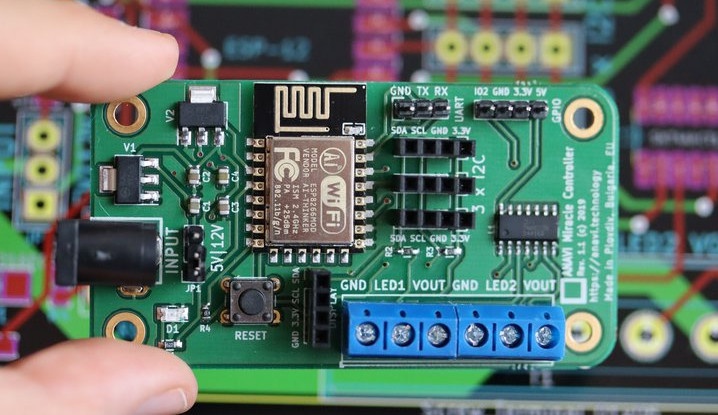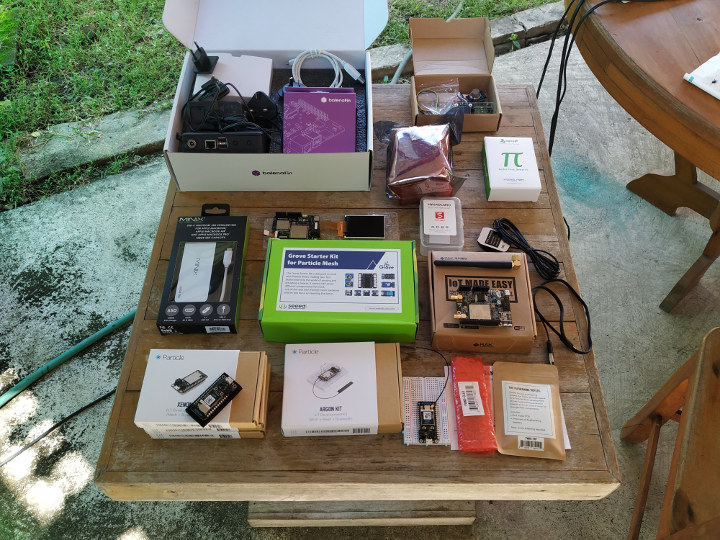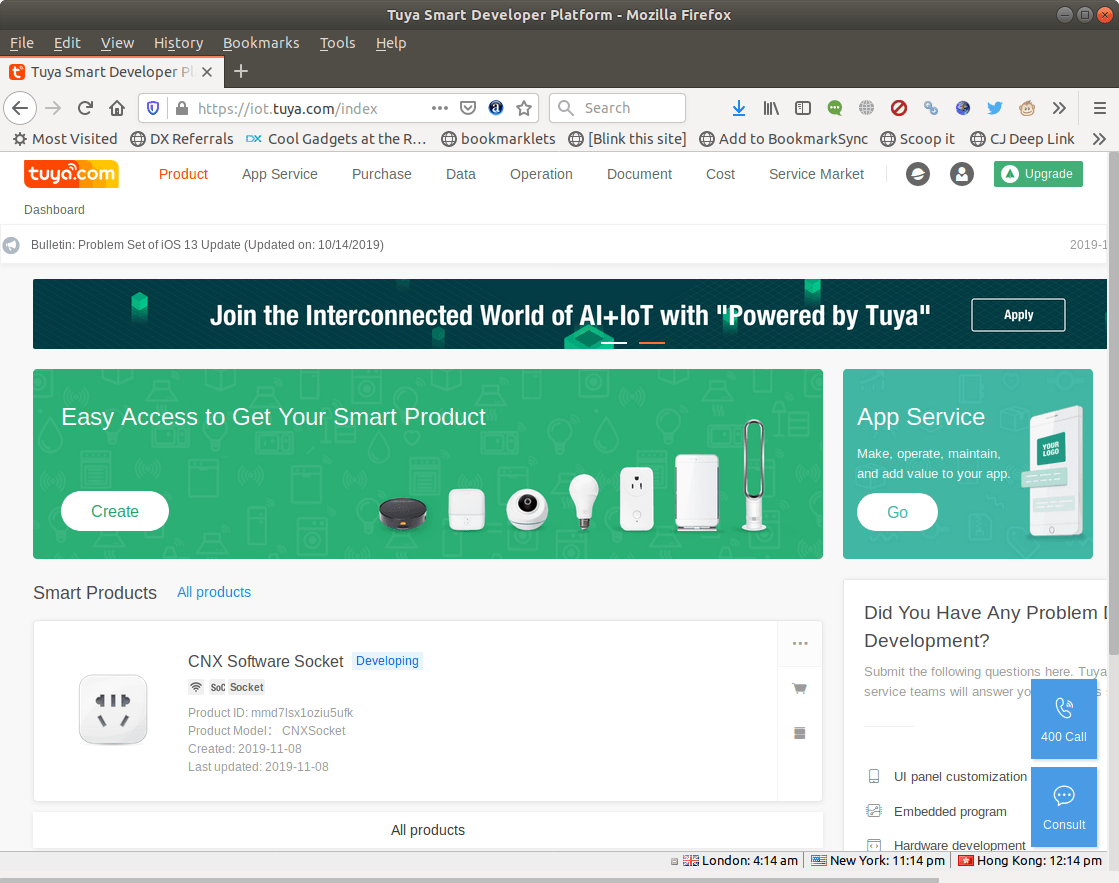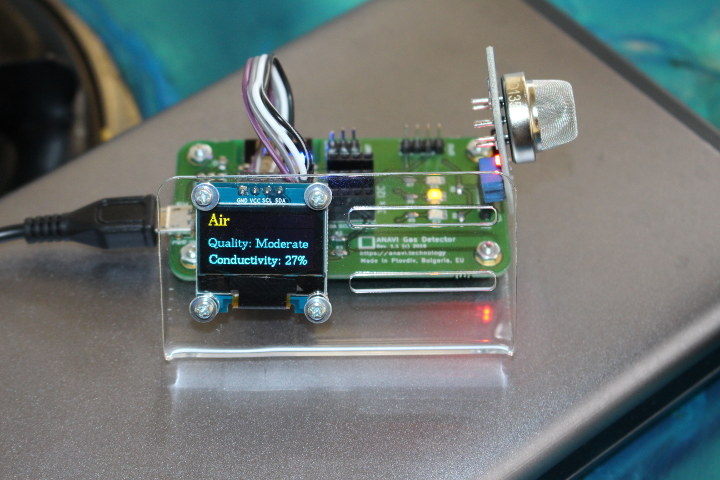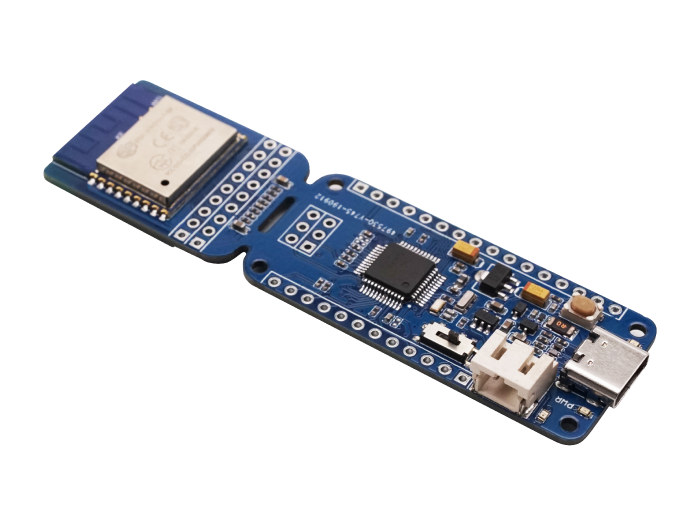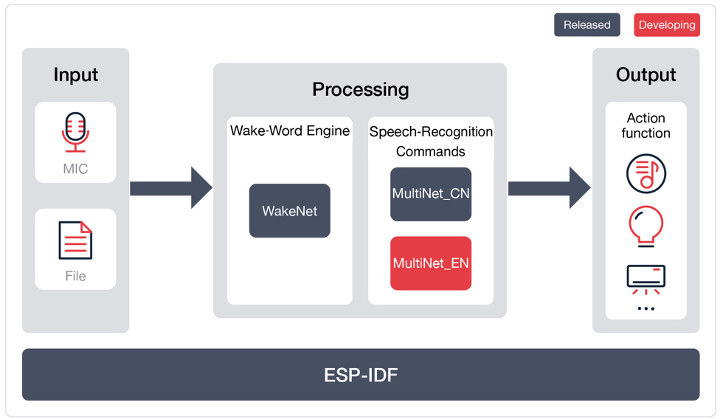You can have a product based on a microcontroller and operating fully offline, for example, a washing machine. But you’d now like to update your appliance to connect to the cloud so it can upload data to the cloud, and help your customer access it. This is a non-trivial update as it requires you to add a communication module be it WiFi or Ethernet, or a new microcontroller that would require you to update your firmware to support networking and other new features. You’d also need to develop your own cloud platform, and potentially a smartphone app. Cesanta VCON platform aims to simplify the upgrade with firmware that can be flashed to ESP8266 or ESP32 module, and remotely upgrade the firmware on STM32 and AVR microcontrollers. On the hardware side, you’d need to wire your existing MCU to the ESP32 module with UART for data, BOOT/RESET for OTA firmware update. […]
ANAVI Miracle Controller WiFi Board Drives Addressable LED strips (Crowdfunding)
Last year, we wrote a tutorial showing how to control an RGB LED strip Control ANAVI Light ESP8266 controller. The board only works with standard non-addressable 12V LED strips however, and Leon ANAVI received requests to support 5V and 12V addressable LED strips such as NeoPixels, WS2811, WS2812, or TM1804. So he updated ANAVI Light Controller design and has now launched a new open-source hardware certified board based on ESP8266 WiFi chip: ANAVI Miracle Controller. ANAVI Miracle Controller specifications: MCU – Espressif Systems ESP8266 Tensilica L106 32-bit processor Connectivity – Wi-Fi 4 802.11 b/g/n LED Strips Support – Up to two 5V or 12 V addressable LED strips; Supported models include WS2812, WS2812B, WS2811, TM1804, etc. (LED strip chipsets supported by the FastLED library) Expansion 4x I2C header for mini OLED display, sensors, and others 4-pin “GPIO” header with 1x GPIO, GND, 3.3V, and 5V signals Misc – Reset button, […]
Giveaway Week Winners – November 2019
We just had another of our yearly “Giveaway week” on CNX Software with 7 prizes including Arm and RISC-V development boards, NB-IoT tracker, USB-C hub, as well as development kits based on ESP32 or ESP8266 WiSoCs. People just had to comment within a 48 hours period, and we would randomly select a winner each day. We now have all confirmed winners with a strong start from Europe, Asia catching up mid-week, before with Poland and Brazil taking the week-end prizes: Balena Fin Developer Kit – Laurent H, FRANCE WisCellular NB-IoT & eMTC GPS Tracker – Jimmy, SWEDEN MINIX NEO S1 USB-C Hub with 120GB built-in SSD – Jeroen, BELGIUM Maixduino Sipeed M1 RISC-V AI Kit – Nguyen Tung, VIETNAM ANAVI Gas Detector Starter Kit – Bumsik Kim, SOUTH KOREA Particle Mesh IoT Development Kit – Wojciech Lubicz-Lapinski, POLAND NanoPi M4V2 SBC & Metal Case Kit – Thiago Tavares, BRAZIL I […]
Tuya helps you easily Design & Manufacture your own Smart Home Solutions
I was recently informed about LSC Smart Connect 3 door sensor selling on Action discounter with over 600 stores across the Netherlands, Belgium, France, Germany, Luxembourg, Austria, and Poland. The door sensor is based on ESP8266, and people have bought a few and flashed their own open source firmware converting the device into a multi-purpose sensor device with ESPNOW protocol that enables direct and low-power control of Espressif devices without the need of a router. The module inside the door sensor is called TYWE3S, which one document on the FCC website refers to as “Tuya WiFi module” and further mentions “TYWE3S is a low-power consumption module with built-in Wi-Fi solution designed by Hangzhou Tuya Technology Corporation” that is based on ESP8266 WiSoC with 1MB flash, 50 kB RAM. One person in the LetsControlIt forum thread linked above explains the stock firmware can be updated over-the-air via a Raspberry Pi 3/3+ […]
Giveaway Week – ANAVI Gas Detector Starter Kit
Leon ANAVI makes from fun little boards for home automation, either ESP8266 based, or pHAT for Raspberry Pi boards. Earlier this year, I wrote about my experience getting ANAVI Gas Detector with Home Assistant. Now that’s I’m done, I’m giving away the starter kit that includes the ESP8266 board, an acrylic case, an OLED display, a USB to serial adapter, and MQ135 air quality sensor. The board is open-source hardware, meaning everything is open source from the KiCAD files to the Android sketch running on the board. It’s very easy to get started, as you can just connect a USB cable for power, and after configuring WiFi you can see the air quality – either Poor, Moderate or Good – displayed on the OLED display, and you can easily see the data in a web dashboard after setting up Home Assistant. Everything shown in the top photo will be given […]
Wio Lite RISC-V WiFi Board with ESP8266 Module Launches for $6.9
Released this summer, GigaDevice GD32V generated a lot of buzz, as a cheap general-purpose 32-bit RISC-V MCU, and soon after the $5 Longan Nano development board with LCD display and enclosure was launched to the market. However, many applications benefit or require some network connectivity with WiFi. Espressif Systems is a founding member of the RISC-V Foundation, so RISC-V WiSoCs (Wireless SoCs) are coming, but AFAIK none of those are available yet. In the meantime, Seeed Studio has launched Wio Lite RISC-V board which brings WiFi connectivity to GD32V MCU through an ESP8266 WiFi module. Wio Lite specifications: MCU – Gigadevice GD32VF103CBT6 RISC-V (rv32imac) microcontroller @ 108 MHz with 128KB Flash, 32KB SRAM Wireless Module – ESP8266 WiFi Wio Core with 802.11b/g/n/ WiFi 4 connectivity Storage – MicroSD card slot USB – 1x USB Type-C port for power and programming Expansion – I/O headers for GD32 MCU, I/O header for […]
Espressif ESP-Skainet Voice Assistant Offers Wake Word Engine and Speech Commands Recognition for Embedded MCUs
Skynet is finally here! OK, not quite, but at least we do have ESP-Skainet now courtesy of Espressif Systems. ESP-Skainet is an intelligent voice assistant that features the company’s WakeNet wake word engine and MultiNet speech commands recognition. WakeNet WakeNet has been specifically designed for low-power MCUs such as ESP8266 or ESP32 with a low memory footprint (20KB RAM) and a high calculation speed that makes it capable of achieving a high success rate for wake word detection even in noisy environments. Tested in the company’s upcoming LyraT-Mini audio board that combines an ESP32-WROVER-B module and a codec, WakeNet achieves a 97% wake word success rate at a one-meter distance, and 95% three meters away in a quiet environment. ESP-Skainet wake-up engine ships with the wake-up word “嗨乐鑫” (Hi Lexin), which translates in “Hello Espressif”, and supports up to five wake words. You can use customize wake words as well, […]
Getting Started with ANAVI Gas Detector Starter Kit and Home Assistant
ANAVI Gas Detector is an ESP8266 based board designed for MQ gas sensors supported by Arduino. This allows you to easily monitor air quality, or more accurately air conductivity using MQ-135 sensor as part of the starter kit either visually on the OLED display, or through your smartphone or computer using MQTT via automation platform such as Home Assistant. Leon Anavi sent me an ANAVI Gas Detector Starter Kit to have a look, and I’ll report my experience with the kit using it standalone, and through Home Assistant. Starter Kit Unboxing The kit contains the open-source hardware, ESP8266 based ANAVI Gas Detector board, a plastic stand, an OLED display, a USB to serial adapter, a gas sensor, and a few KiCad and ANAVI stickers. The board itself comes with an ESP8266MOD module, features a micro USB port for power, a reset button, four LEDs, a UART console, a 4-pin GPIO […]



